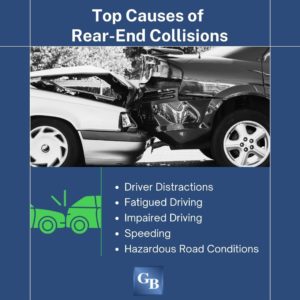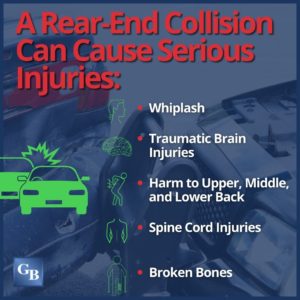Rear-End Collisions
The National Highway Traffic Safety Administration (NHTSA) reports that rear-end car accidents are the most common type of collision. Rear-end crashes can cause substantial injuries and even death. The term “fender-bender” downplays the severity of many rear-end collisions. While some rear-end crashes are minor, they can still cause significant damage to your vehicle and your health.
A rear-end collision happens when a driver hits the vehicle directly in front of them from behind. Sometimes, the force of the hit will push that vehicle other vehicles, causing a multi-vehicle accident.
Rear-end collisions often happen at red lights, stop signs, or when traffic slows due to traffic congestion or road work. These collisions may occur at low speeds but also happen when a speeding car on a highway cannot stop in time for the slower traffic ahead.
Examples of rear-end collisions include:
- The rear driver accidentally rolled forward at low speed at an upcoming light and hit the back of the front driver’s vehicle.
- The rear driver was traveling faster than the front driver and hit the front driver’s vehicle while both cars were in motion.
- The rear driver was speeding and violently crashed into the back of a stopped vehicle at a red light.
- The rear driver was speeding and tried to brake for stopped traffic but could not come to a complete stop in time, plowing into the car in front.
- A rear driver was driving too fast on a slick road and could not avoid the car ahead that was stopped at a stop sign.
- A hurried rear driver was tailgating the driver in front of them and crashed into the back of their car when the front driver suddenly slowed for a traffic tie-up.
There are many other variations of rear-end crashes. In almost all cases, a rear-end crash will cause an accident with vehicle damage and bodily injuries. The collision’s severity depends on road conditions, how fast the vehicles were traveling, and even the types of vehicles involved.
The most devastating accidents occur when a fast-moving vehicle hits a stopped car. The force of the collision can be devastating. Any rear-end collision can cause one or both vehicles to slide, run off the road, veer into a neighboring lane, or even roll over.
 Google Screened
Google Screened


